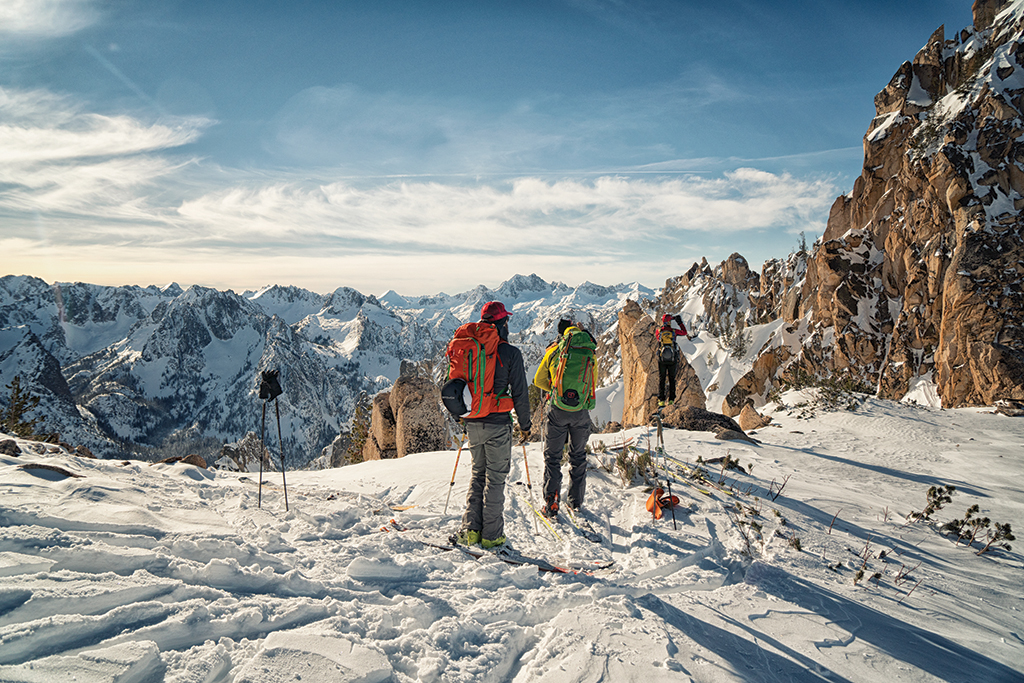As autumn closes and early winter opens, the leaves that once rustled on the trees are laid to rest beneath a crystalline blanket. Dawn and dusk, no longer peppered by birdsong, are void of sound but vibrant in color as pinks and blues cast their tones on a blank snowy canvass. Busy minds surrender to play and days of sweat and laughter. Ski buddies study the day’s brilliant and thorough avalanche forecast and pursue new ridgelines in hope of a rare mountain goat sighting. The human powered pursuit of an ever-changing horizon makes backcountry skiing the dynamic adventure that holds the heart of our community.
Today, backcountry users have slope angle shaded maps, waterproof layers, and carbon skis to help them enjoy fun in snow-covered mountains. It wasn’t always this way. Before there were ski edits and gear sponsorships there was a sport born of necessity. Surviving winter is hard work and anyone who has spent time in the high mountains of central Idaho can attest to that. For hundreds of years, skiing was a means of movement for survival and subsistence during the harshest season for living things. Over time, creative minds developed climbing skins, new techniques for descending steeper slopes, and avalanche rescue gear. In the wake of this creativity came the stoke filled fun that we know today– bell to bell resort days and face shot filled backcountry days.
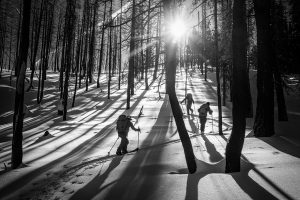
An early morning climb through a stand of burned trees us a reminder of the power and force of nature.
I grew up riding chairlifts, but it seems that, after two decades of lapping my favorite chair lifts, my transition to backcountry skiing was inevitable. I was two years out of college trying to save every penny, chase every dream, and get one hundred or more days logged on my season pass. I was falling short in each category and craved a way to stay connected to my favorite sport without being married to a resort. Everything changed the day my first backcountry setup was mounted. A few coworkers and I stayed after our shift at the ski shop where we worked, cracked some beers, turned on some music, and set up the jig. I had bought used skis from our rental fleet, used skins on eBay, bindings and an avy rescue kit with a pro deal. The whole rig was topped off with a touring pack purchased from the local mountaineering shop and, when it all came together, I was in awe. I was going to be able to skin up to ski down.
That’s the kit I showed up with for my first season at Sawtooth Mountain Guides. Weighing in at 23 pounds, that setup added extra effort to already hearty porter loads but it worked. It worked for slushy summer skiing in shorts. It worked for breaking trail to the Williams Peak hut. It worked on my first 3,000 vertical foot day of backcountry powder. It worked for sunset party laps with more dogs than humans. It was my gateway into a world sprinkled in pixie dust… or maybe it was snow.
I have since graduated to a lighter setup but the goal remains the same– dawn patrol missions with trusted partners and ear to ear grins on powder days. Whatever you ride, the gear is simply a catalyst for the excitement to come.
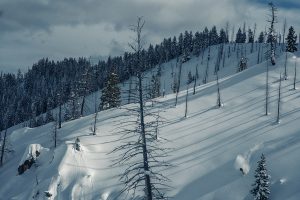
An expression of joy-first tracks down an open face of powder after a long climb.
Joy and risk exist symbiotically in backcountry skiing. Humanity has had a lot of practice with risk assessment and decision making this past year. People are searching for clarity in nature and connection outdoors and, as a result, the backcountry is busier than ever. Wild landscapes offer unparalleled freedom, but that liberty must be informed or a trip into the backcountry can prove disastrous, or even deadly. The importance of safety, knowledge, clear plans that have specific parameters, and trusted backcountry partners with the same goals and parameters can not be emphasized enough.
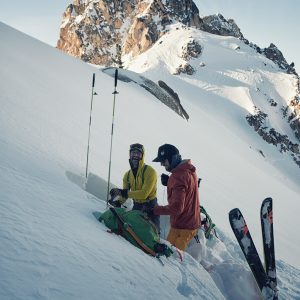
Adam Wirth and Brett Nichols digging a test in the pit in the Sawtooths to asses risk
When you are out in the backcountry, the people you are with become your lifeline should anything not go as originally
planned, but there are some simple steps for recreationalists of all levels to consider. First and foremost, invest in safety. Take an avalanche course and keep your knowledge current. Invest in reliable avalanche rescue equipment–beacon, probe, shovel– and practice using them often.
Also follow the basic tenet of “Know Before You Go (KBYG). KBYG (www.kbyg.org) is an education initiative with free resources to help people learn safe backcountry practices. KBYG makes an important distinction; “when you are off the highway or outside of the resort in snow-covered mountains, you are in avalanche country,” which means that every time you go out you should consider the weather, terrain, avalanche conditions, and resources you have in case of an emergency situation.
Even if you are armed with all the knowledge, education and high-tech gear on the planet, it is also vitally important to have a plan before you venture into the backcountry. Set your limits each day
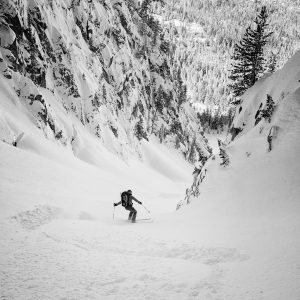
Dropping into Gun Barrel Couloir in the Sawtooth Mountains
before you get after it and discuss them with your ski partner or group. It’s easy to get caught up in the moment when faced
with an untracked powdery slope. Having parameters in place ahead of time can help keep you safe.
Choose partners with similar avalanche education, or better, and choose partners with similar risk tolerance. The backcountry has high stakes and incredible rewards; it is best to navigate that with someone you trust. A lifetime of powder days is better than just one, so the decisions you and your partners make should reflect that.
And finally, remember this: With the influx of users and the early season snowfall, this winter is shaping up to be a big one in the backcountry. The mountains above the Wood River Valley and Sawtooth Valley are a wellspring of untapped adventure. All they demand is respect.


